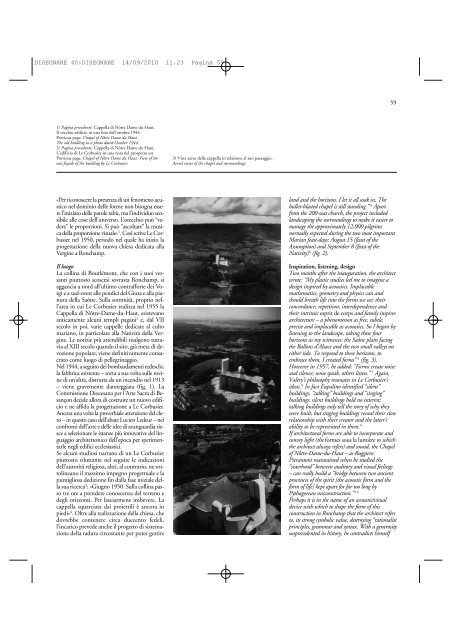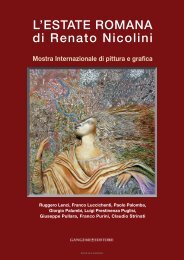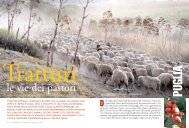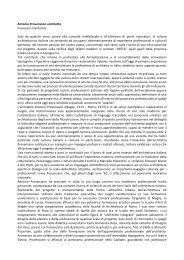Recondite Armonie - Archiwatch
Recondite Armonie - Archiwatch
Recondite Armonie - Archiwatch
Create successful ePaper yourself
Turn your PDF publications into a flip-book with our unique Google optimized e-Paper software.
DISEGNARE 40:DISEGNARE 14/09/2010 11.23 Pagina 59<br />
59<br />
1/ Pagina precedente. Cappella di Nôtre Dame du Haut.<br />
Il vecchio edificio in una foto dell’ottobre 1944.<br />
Previous page. Chapel of Nôtre Dame du Haut.<br />
The old building in a photo dated October 1944.<br />
2/ Pagina precedente. Cappella di Nôtre Dame du Haut.<br />
L’edificio di Le Corbusier in una vista del prospetto est.<br />
Previous page. Chapel of Nôtre Dame du Haut. View of the<br />
east façade of the building by Le Corbusier.<br />
3/ Viste aeree della cappella in relazione al suo paesaggio.<br />
Aerial views of the chapel and surroundings.<br />
«Per riconoscere la presenza di un fenomeno acustico<br />
nel dominio delle forme non bisogna essere<br />
l’iniziato delle parole tabù, ma l’individuo sensibile<br />
alle cose dell’universo. L’orecchio può “vedere”<br />
le proporzioni. Si può “ascoltare” la musica<br />
della proporzione visuale» 1 . Così scrive Le Corbusier<br />
nel 1950, periodo nel quale ha inizio la<br />
progettazione della nuova chiesa dedicata alla<br />
Vergine a Ronchamp.<br />
Il luogo<br />
La collina di Bourlémont, che con i suoi versanti<br />
piuttosto scoscesi sovrasta Ronchamp, si<br />
aggancia a nord all’ultimo contrafforte dei Vosgi<br />
e a sud-ovest alle pendici del Giura e alla pianura<br />
della Saône. Sulla sommità, proprio nell’area<br />
in cui Le Corbusier realizza nel 1955 la<br />
Cappella di Nôtre-Dame-du-Haut, esistevano<br />
anticamente alcuni templi pagani 2 e, dal VII<br />
secolo in poi, varie cappelle dedicate al culto<br />
mariano, in particolare alla Natività della Vergine.<br />
Le notizie più attendibili risalgono tuttavia<br />
al XIII secolo quando il sito, già meta di devozione<br />
popolare, viene definitivamente consacrato<br />
come luogo di pellegrinaggio.<br />
Nel 1944, a seguito dei bombardamenti tedeschi,<br />
la fabbrica esistente – sorta a sua volta sulle rovine<br />
di un’altra, distrutta da un incendio nel 1913<br />
– viene gravemente danneggiata (fig. 1). La<br />
Commissione Diocesana per l’Arte Sacra di Besançon<br />
decide allora di costruire un nuovo edificio<br />
e ne affida la progettazione a Le Corbusier.<br />
Ancora una volta la proverbiale attenzione del clero<br />
– in questo caso dell’abate Lucien Ledeur – nei<br />
confronti dell’arte e delle idee di avanguardia riesce<br />
a selezionare le istanze più innovative del linguaggio<br />
architettonico dell’epoca per sperimentarle<br />
negli edifici ecclesiastici.<br />
Se alcuni studiosi narrano di un Le Corbusier<br />
piuttosto riluttante nel seguire le indicazioni<br />
dell’autorità religiosa, altri, al contrario, ne sottolineano<br />
il massimo impegno progettuale e la<br />
puntigliosa dedizione fin dalla fase iniziale della<br />
sua ricerca 3 : «Giugno 1950. Sulla collina passo<br />
tre ore a prendere conoscenza del terreno e<br />
degli orizzonti. Per lasciarmene imbevere. La<br />
cappella squarciata dai proiettili è ancora in<br />
piedi» 4 . Oltre alla realizzazione della chiesa, che<br />
dovrebbe contenere circa duecento fedeli,<br />
l’incarico prevede anche il progetto di sistemazione<br />
della radura circostante per poter gestire<br />
land and the horizons. I let it all soak in. The<br />
bullet-blasted chapel is still standing.” 4 Apart<br />
from the 200-seat church, the project included<br />
landscaping the surroundings to make it easier to<br />
manage the approximately 12,000 pilgrims<br />
normally expected during the two most important<br />
Marian feast-days: August 15 (feast of the<br />
Assumption) and September 8 (feast of the<br />
Nativity) 5 (fig. 2).<br />
Inspiration, listening, design<br />
Two months after the inauguration, the architect<br />
wrote: “My plastic studies led me to imagine a<br />
design inspired by acoustics. Implacable<br />
mathematics, geometry and physics can and<br />
should breath life into the forms we see; their<br />
concordance, repetition, interdependence and<br />
their intrinsic esprit de corps and family inspires<br />
architecture – a phenomenon as free, subtle,<br />
precise and implacable as acoustics. So I began by<br />
listening to the landscape, taking these four<br />
horizons as my witnesses: the Saône plain facing<br />
the Ballons d’Alsace and the two small valleys on<br />
either side. To respond to these horizons, to<br />
embrace them, I created forms” 6 (fig. 3).<br />
However in 1957, he added: “Forms create noise<br />
and silence; some speak, others listen.” 7 Again,<br />
Valèry’s philosophy resonates in Le Corbusier’s<br />
ideas. 8 In fact Eupalino identified “silent”<br />
buildings, “talking” buildings and “singing”<br />
buildings: silent buildings hold no interest;<br />
talking buildings only tell the story of why they<br />
were built, but singing buildings reveal their close<br />
relationship with their creator and the latter’s<br />
ability to be represented in them. 9<br />
If architectural forms are able to incorporate and<br />
convey light (the formes sous la lumière to which<br />
the architect always refers) and sound, the Chapel<br />
of Nôtre-Dame-du-Haut – as Ruggiero<br />
Pierantoni maintained when he studied the<br />
“sisterhood” between auditory and visual feelings<br />
– can really build a “bridge between two ancient<br />
provinces of the spirit [the acoustic form and the<br />
form of life] kept apart for far too long by<br />
Pythagorean misconstruction.” 10<br />
Perhaps it is in the name of an acoustic/visual<br />
device with which to shape the form of this<br />
construction in Ronchamp that the architect refers<br />
to, its strong symbolic value, destroying “rationalist<br />
principles, grammar and syntax. With a generosity<br />
unprecedented in history, he contradicts himself






